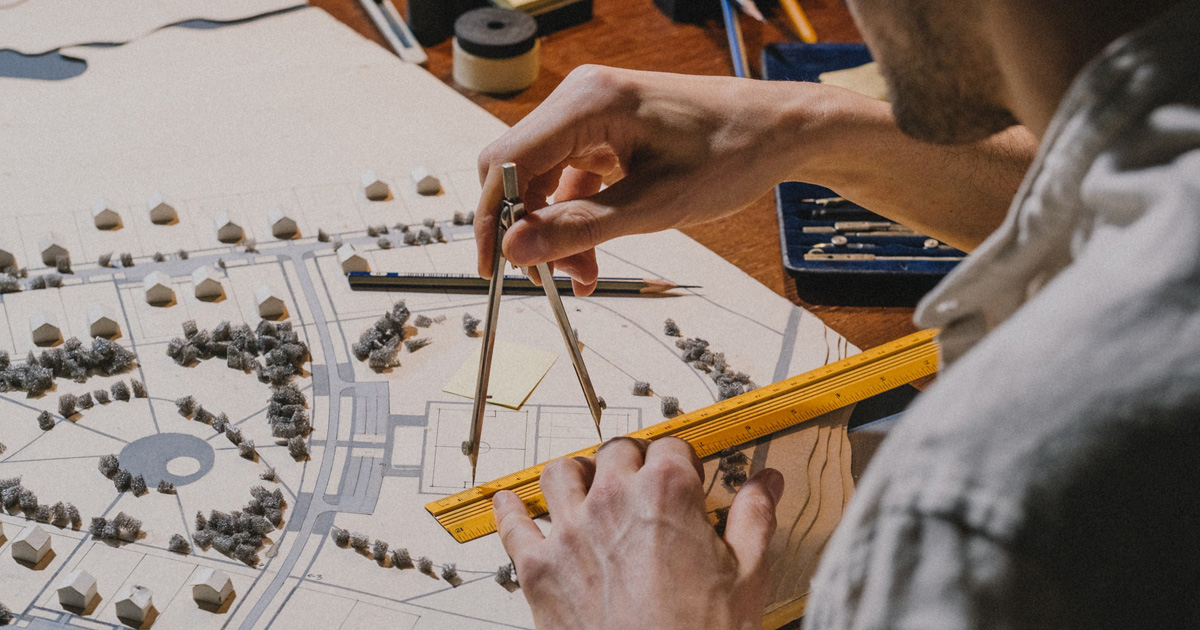Architect Guide to Sustainable Building Materials
Wiki Article
Recognizing the Diverse Job Paths Available for Aspiring Architect
As an aspiring Architect, you have a globe of profession paths waiting for you. Whether you're drawn to typical architecture or the subtleties of sustainable layout, there's a niche that aligns with your passions.Typical Architecture: Creating Structures and Structures
Conventional style concentrates on creating structures and frameworks that mix capability with visual allure. As you discover this area, you'll value the intricate balance in between type and purpose. You'll find out to draw motivation from historic designs, integrating elements like proportion, materials, and workmanship. Your styles can reflect cultural heritage, showcasing local practices while satisfying modern-day demands.You'll create skills in preparing, model-making, and website evaluation, allowing you to visualize and connect your concepts effectively. Engaging with customers, you'll require to comprehend their vision and convert it into practical styles.
Moreover, developing codes and sustainability techniques are essential in your job, guaranteeing your structures are ecologically friendly and risk-free. As you grow in your career, you'll locate opportunities in household, industrial, or even restoration tasks, each offering distinct obstacles. Embracing standard design leads the method for a satisfying profession that admires the past while forming the future.
Urban Preparation: Shaping Areas and Public Spaces
As an ambitious Architect, you can play an essential duty as a metropolitan planner, transforming how areas communicate and work. By utilizing community engagement approaches, you'll ensure that residents have a voice in forming their setting. And also, integrating lasting layout principles will help develop spaces that not just fulfill today's requirements yet also secure the future.Function of Urban Planners
While several may believe of engineers as the sole dreamers behind buildings, city organizers play an important function in shaping the more comprehensive landscape of neighborhoods and public spaces. By teaming up with numerous stakeholders, you'll help make parks, transport systems, and domestic areas that advertise social interaction and accessibility. Your know-how in spatial layout and area characteristics enables you to imagine future growth while protecting cultural heritage.Community Engagement Techniques
Efficient area involvement approaches are crucial for urban planners to guarantee that the voices of citizens are listened to and valued in the planning process. To foster purposeful dialogue, you should focus on open forums and workshops where neighborhood participants can express their concepts and concerns. Usage studies and social networks to reach a broader target market, making certain varied perspectives are consisted of. Teaming up with regional organizations can enhance depend on and help with much deeper connections. It is necessary to give clear details about decision-making processes and proposed jobs, permitting citizens to really feel educated and empowered. By proactively integrating and listening comments, you'll develop rooms that show the neighborhood's needs, ultimately leading to even more sustainable and effective city atmospheres. Embrace openness and continuous dialogue for enduring influence.Lasting Design Principles
When developing metropolitan rooms, including lasting design concepts is crucial for producing atmospheres that grow both environmentally and socially. Consider incorporating green spaces, like parks and yards, to enhance biodiversity and boost air top quality.Designing with water preservation in mind is also vital-- assume regarding rain yards and absorptive surface areas to handle stormwater. Involving community participants throughout the preparation process assurances that the areas you create satisfy their demands and encourage social interaction. By embracing these concepts, you'll contribute to dynamic, sustainable metropolitan landscapes that profit every person.

Landscape Design: Developing Sustainable Outside Environments
As you discover landscape design, you'll find important design concepts that develop beautiful and useful outside areas. Lasting practices play a crucial duty in guaranteeing these settings prosper while reducing environmental influence. And also, you'll find a variety of career possibilities that enable you to make a genuine difference in exactly how people communicate with nature.Style Principles in Landscape
Recognizing style concepts in landscape architecture is vital for developing sustainable exterior atmospheres that harmonize with nature. You'll require to consider aspects like proportion, scale, and balance to guarantee your layouts feel cohesive and welcoming. In addition, pay attention to seasonal changes, developing with materials that enhance the environments year-round.Sustainable Practices Summary
Sustainable techniques in landscape architecture not just concentrate on looks but additionally focus on environmental health and wellness and resource conservation. By incorporating indigenous plants, you enhance biodiversity and lower the requirement for chemical fertilizers and chemicals. Executing reliable irrigation systems assists save water and reduces drainage, safeguarding close-by ecosystems. You can design areas that promote a knockout post soil health, such as utilizing natural products and practicing permaculture principles. Additionally, incorporating green infrastructure, like rainfall gardens and permeable sidewalks, aids in stormwater management and lowers metropolitan warmth. When you create exterior atmospheres with sustainability in mind, you contribute to a much healthier world and offer areas that cultivate community connection. Inevitably, these methods guarantee your styles benefit both people and the environment for years ahead.Career Opportunities Exploration
With a strong structure in lasting practices, landscape architecture supplies a range of profession courses that enable you to make a meaningful influence on the atmosphere. Urban planners often team up with landscape designers to develop environment-friendly areas in city settings, improving city livability. If you're enthusiastic about education and learning, think about coming to be a landscape design educator, inspiring future generations.Sustainable Layout: Concentrating on Eco-Friendly Practices
As you explore your job in design, welcoming green practices can set you apart in a competitive field. Lasting style concentrates on creating structures that lessen environmental influence while boosting resident health. By incorporating renewable products, energy-efficient systems, and sustainable building strategies, you'll add to a greener future.Begin by gaining understanding of environment-friendly certifications like LEED or BREEAM, which can boost your credentials. Think about exactly how natural light, ventilation, and thermal efficiency can maximize layout. Team up with engineers and ecological professionals to introduce remedies that reduce waste and conserve resources.
Don't forget the value of area participation-- appealing regional stakeholders can motivate layouts that integrate with the setting. As clients significantly focus on sustainability, your know-how in environmentally friendly methods will not just attract jobs but also fulfill your interest for liable style. Accept this crucial element of the profession, and enjoy your career thrive.
Historical Conservation: Securing and Bring Back Social Heritage
While you begin on your building journey, consider the crucial duty of historical preservation in preserving our social heritage. This area concentrates on the protection and reconstruction of substantial buildings, sites, and frameworks that tell the stories of our past. By taking part in historic preservation, you'll assist safeguard the architectural legacy that forms area identification.As a historical preservation Architect, you'll assess historical importance and assess the condition of frameworks. You'll work carefully with chroniclers and guardians to ensure authentic remediation techniques are used. This profession path enables you to mix imagination with study, enabling you to make options that appreciate initial products and workmanship.
Your job not only adds to sustainability by recycling existing buildings however also promotes a feeling of satisfaction within areas. Accepting this course will help you come to be a guardian of history, maintaining the stories and aesthetic appeals that enrich our lives.
Interior Architecture: Enhancing Indoor Spaces
Historical conservation and indoor architecture both share a commitment to improving the built atmosphere, yet they concentrate on various aspects. While historical conservation emphasizes maintaining a structure's historical and social value, indoor architecture zeroes in on optimizing interior rooms for performance and aesthetics.As a hopeful Architect, you'll discover that indoor style permits you to mix creativity with technical skills. You'll create rooms that not only look excellent however additionally advertise comfort and performance. This area involves understanding exactly how light, shade, and materials engage within an area, impacting state of mind and use.
You'll work on different projects, from domestic homes to industrial offices, making certain that each atmosphere fulfills the requirements of its owners. By prioritizing customer experience, you can change insides right into motivating and useful rooms, making a considerable effect on just how people interact with their surroundings. Accept the possibility to improve interior atmospheres and shape the means people function and live.
Industrial Design: Combining Capability With Aesthetic Appeals
Commercial style plays an essential function in producing items that perfectly mix visual appeals with capability, guaranteeing that what you make use of daily is not just visually appealing but also useful. As an ambitious Architect, you could involve yourself in this field, concentrating on developing everything from furniture to customer electronic devices. Your job includes recognizing individual requirements, materials, and producing processes, enabling you to produce cutting-edge services that enhance daily experiences.In industrial style, you'll usually team up with designers, marketing experts, and suppliers, making certain that your layouts are not just beautiful but also viable. You'll discover to balance type and feature, prioritizing use without sacrificing style. By honing your abilities in sketching, news 3D modeling, and prototyping, you'll be fully equipped to bring your ideas to life. This career path provides a dynamic setting where creative thinking fulfills practicality, making it a gratifying selection for engineers interested in forming the items of tomorrow.
Frequently Asked Questions
What Educational Credentials Do I Need to Become an Engineer?
To come to be an architect, you'll need a specialist degree in style, generally a Bachelor's or Master's. Furthermore, you'll have to finish an internship and pass the Architect Registration Evaluation to exercise lawfully.Exist Qualification Needs for Various Building Job Paths?
Yes, there're accreditation needs for various architectural paths. Architect. You'll need to pass exams, total internships, and often go after specialized training, relying on your picked emphasis, like landscape official site architecture, urban style, or historic preservationWhat Software Program Skills Are Essential for Designers Today?

Exactly How Can I Gain Practical Experience While Studying Design?
You can obtain sensible experience by interning at architectural companies, taking part in layout competitors, volunteering for community tasks, or collaborating with schoolmates on real-world tasks. These opportunities improve your skills and develop beneficial connections in the sector.What Job Opportunities Exist Outside Typical Architecture Firms?
You can discover various task chances outside traditional architecture companies, like metropolitan preparation, indoor style, landscape design, construction monitoring, property growth, and even roles in sustainability consulting. Each offers unique difficulties and incentives.Whether you're drawn to standard style or the nuances of lasting design, there's a particular niche that aligns with your passions.When designing city areas, including lasting style principles is important for developing atmospheres that grow both ecologically and socially.As you check out landscape style, you'll find vital layout concepts that develop beautiful and functional outdoor rooms.Understanding layout principles in landscape style is essential for creating sustainable outside atmospheres that integrate with nature.In commercial style, you'll frequently work together with marketing professionals, producers, and designers, guaranteeing that your designs are not just lovely but likewise possible.
Report this wiki page